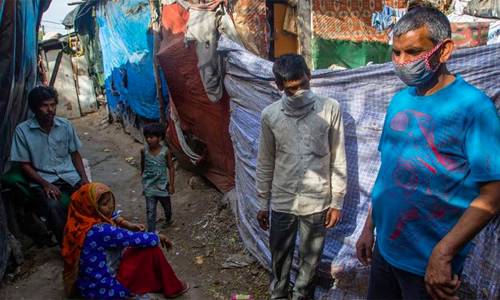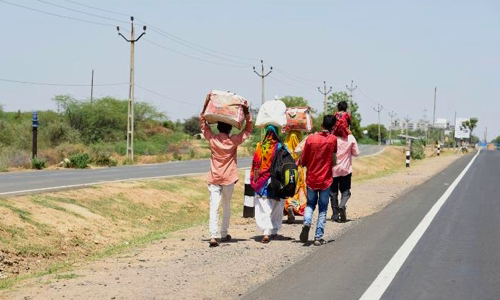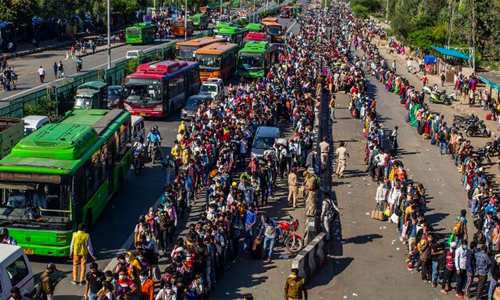For two days, Jeetender Mahender, 36, dared not leave his family's shack in a slum north of Mumbai, except to go to the toilet.
His situation was very tragic. The small shack in the Valmiki slum does not have running water or toilet, the family is about to run out of food. Mahender could not work and had no income. He is trying to comply with Prime Minister Narenda Modi's 21-day blockade to curb the spread of nCoV. The nation of 1.3 billion people currently records more than 1,000 infections and 27 deaths.

People in a Mumbai slum, most without a mask, say they will starve because they cannot work, not because of nCoV Photo: AFP
"The community gap is not only with the sick, but also with each other, including friends and even your family," Modi said in a speech last week.
That is suitable for India's middle and upper classes, who can avoid translating in apartments, walking in their gardens, enjoying food from cupboards full of food and even Work from home with the support of modern technology.
However, the chaos that has occurred throughout India in recent days suggests that with 74 million people, or one sixth of the population, living precariously in slums, it is impossible to distance the community.
"The path is so narrow that when we pass each other, we can't help but touch the other person's shoulder," Mahender said. "We all share an outdoor toilet and have 20 families living close to my small house. We are really living together. If one falls ill, everyone will fall ill as well."
At least one person in a Mumbai slum was positive for nCoV. Worried about the disease, thousands of migrant workers left slums to the countryside by bus, even walking, raising fears they would take the virus home.
In a speech yesterday, aware of the chaos caused by the blockade against the poor, Modi pleaded for forgiveness. However, he also expects everyone to sympathize because there is no other option.
Water is one of the biggest reasons why poor Indians leave their homes every day. Sia, an immigrant builder in Gurugram, near New Delhi, wakes up at 5 am and resists the prime minister's call to stay at home. The reason was that she needed to walk 100 meters to a water tank that served the slums of 70 migrant builders.
Sia is not the only one. Most of the women here wash and wash together every morning and get water for the whole day. There are no showers or bathrooms in the house, this shared tank is their only water source.

Workers leave the city, walking to their countryside along an Indian highway Photo: AFP
The Indian government's Sanitation Committee, which was set up in 2014 to improve infrastructure and eliminate outdoor latrines, claims 100% of households have access to toilets. However, Puneet Srivastava, policy manager at India's Clean Water NGO, said the focus of the committee was to build toilets in households and not include a large number of housing areas. mouse.
For example, in the Dharavi area in Mumbai, only one toilet of 1,440 residents and 78% of community toilets in Mumbai slums lack water tanks, according to a 2019 survey of Mumbai Urban Management Group.
The next reason that people living in slums cannot quarantine themselves is simply that they need to go to work. The income of migrant workers is usually only enough to eat, approximately 140 to 450 rupees per day (1.8 - 6 USD), according to the International Labor Organization. Every day they do not work, they have no income. Not only did this happen after the blockade had started in the past 20 days.
"The supply chains are closed. Workers lose their jobs. They have no money to buy necessities. And unlike the rich, they don't have the money to stock up. They only buy the day's supplies but now supermarkets are out of stock, "says economist Arun Kumar.
Sonia Manikraj, a 21-year-old teacher living in the Dharavi slum, said she had to go out to buy food and because the grocery stores were only open from 11:00 to 15:00, the roads were quite narrow so it was always crowded. .
Therefore, workers face a dilemma: going to work and getting infected, or staying home and starving. There are people who have no choice. For example, sanitation workers considered essential jobs should be excluded from travel restrictions.
"They are required to go to work every day. Some even collect garbage in the hospital, then go home and live in crowded slums," said Milind Ranade, founder of Kachra Vahatuk Shramik Sangh, a held in Mumbai on labor issues, said. "They do not have any protective equipment, such as gloves or masks, nor awareness campaigns to teach them the dangers of transmission of nCoV. What happens when they get it?" sick?".
The Indian government's $ 22.5 billion stimulus package includes medical insurance worth 5 million rupees per person ($ 66.5) at the front line such as doctors, medical staff, and sanitation workers in public hospitals. However, those who live around them and are at risk of getting sick from them are not included.

Thousands of migrant workers wait on buses to return to their homes after a blockade on the outskirts of New Delhi on March 28 Photo: AFP
The economist Kumar said that a wide-scale nCoV test would be effective. By March 29, India had conducted nearly 35,000 tests, the equivalent of 19 tests per million people. The cost of testing in private hospitals or laboratories in India is 4,500 rupees ($ 60), while free testing in public hospitals is very limited.
Mahender, a sanitation worker in an apartment complex in Mumbai, earns 5,000 rupees a month ($ 66) to support his wife, three children and a 78-year-old father. If he needs medical care, he is not subject to insurance support under the government's stimulus package.
"My phone rang and the residents of the building I cleaned were calling me back to work," he said. "But I don't have a mask or gloves, or even soap to wash my hands before eating. I know if today I don't go to work, they will hire someone else."
Over the weekend, tens of thousands of India's 45 million migrant workers began long trips back and forth to the villages. Because the Indian railway system is temporarily shut down, many people have no choice but to walk hundreds of kilometers home. They have very little reason to stay. Most have lost their jobs in the city due to blockades and slums that could spread the virus.
Researchers at the Center for Sustainability last week warned that the global prevalence of Covid-19 was 2-3%, but in Indian slums, the rate may be 20% higher due to living conditions. crowded.
On March 28, authorities in Uttar Pradesh, Bihar and Haryana states arranged hundreds of buses to transport people to the countryside, causing chaos when thousands of people flocked to the terminals, trying to squeeze into the bus. .
Yesterday, Prime Minister Modi ordered all states to blockade the border to prevent the spread of the virus to rural areas. Officials trying to track millions of migrant workers have returned to small villages across the country to demand a 14-day quarantine.
Sia, who lives at the construction site in Gurugram, didn't catch the car. She did not have many options to escape the slum in the middle of the disease.
"Since losing my job, I haven't had any income for 20 days. I was paid 5 USD / day, enough money to support my family," Sia said. "When everything is closed, I believe we have no choice but to live in poverty and filth in this city."



 RhondaBrown
RhondaBrown








